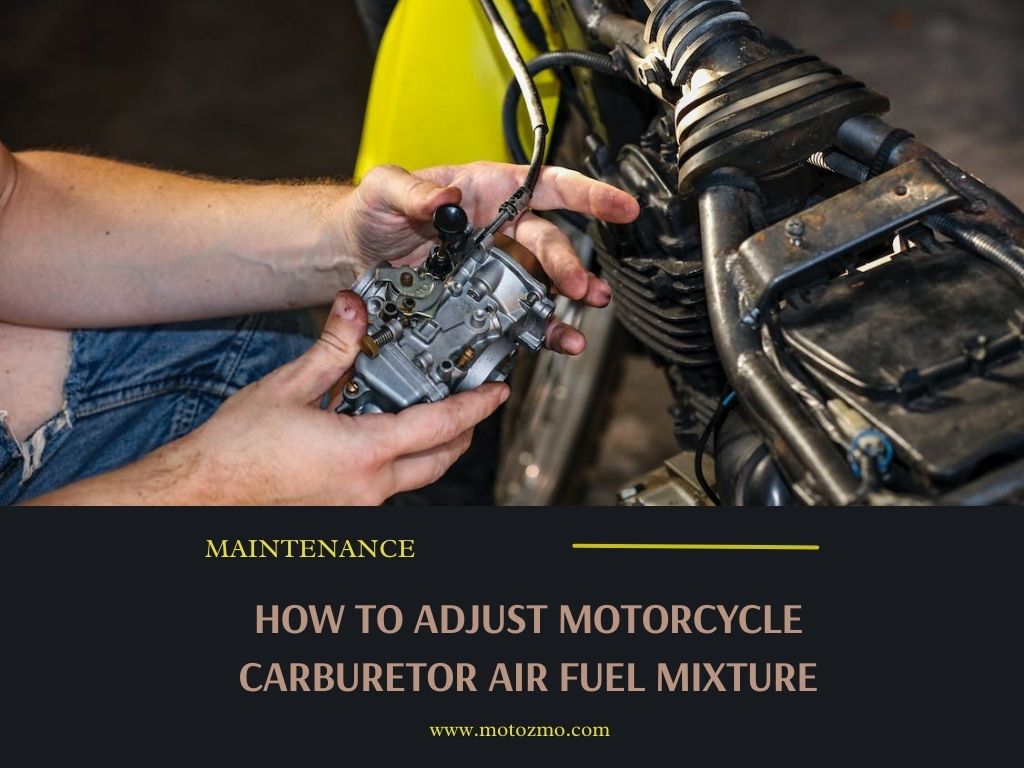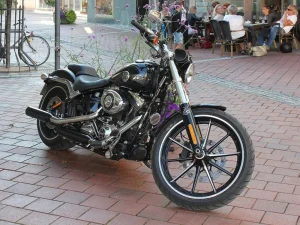🎯 Key Takeaways
- The air-fuel mixture controls how efficiently your motorcycle engine runs.
- Common signs of a poor mixture include: rough idling, hesitation, black exhaust smoke, overheating, and loss of power.
- Adjusting the carburetor helps improve engine performance, throttle response, fuel economy, and engine life.
- Always warm up the engine before making any adjustments.
- Make small adjustments and track your changes for best results.
Is your motorcycle engine sputtering, choking, or losing power? The problem could lie in the carburetor’s air-fuel mixture adjustment. It mixes air and fuel for your engine, and if the ratio is off, your bike won’t run smoothly. Adjusting the carb’s mixture is one of the simpler tasks a home mechanic can do, but it’s important to get it right.
Follow along as I walk through how to assess your air-fuel mixture and adjust the carb jets and valves to dial in the perfect ratio for your riding needs.
How to Tell If the Air Fuel Mixture Is Off?
Your motorcycle shows signs when something’s not right with the carburetor. If the air-fuel ratio is off, the engine will behave differently depending on whether it’s running too rich (too much fuel) or too lean (not enough fuel).
But how do you tell if the mixture is off? Here are the key symptoms to look for:
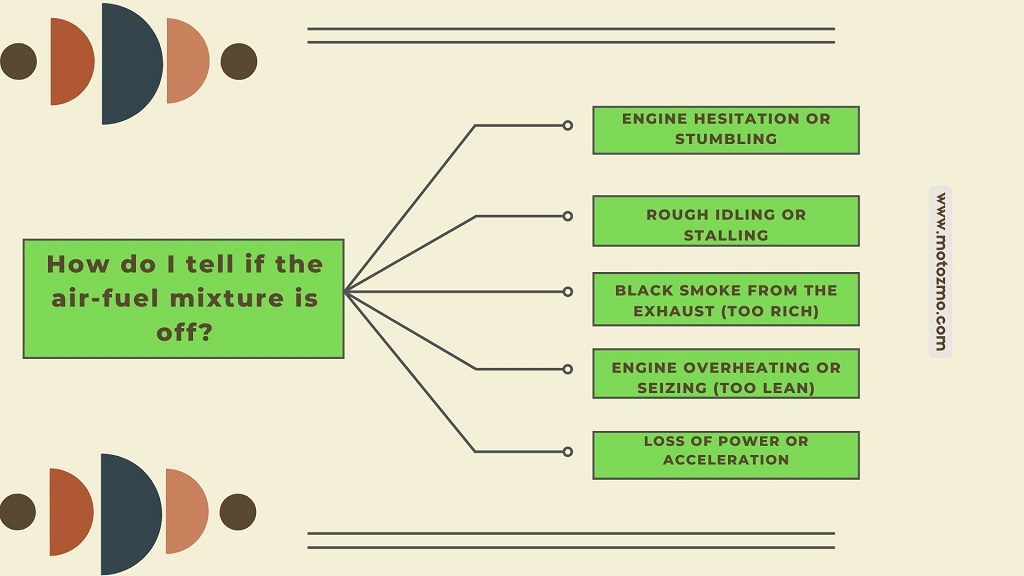
1. Engine Hesitation or Stumbling
When you twist the throttle and the engine hesitates or feels like it’s lagging before speeding up, that’s a sign of an imbalanced mixture.
A lean mixture often causes this delay in throttle response. It might feel like your bike is trying to catch its breath before moving forward.
2. Rough Idling or Stalling
If your engine idles unevenly, vibrates more than usual, or randomly shuts off at stop lights, the idle mixture is likely too far off in either direction.
A rich mix can flood the engine at low speeds, while a lean mix can make it sputter or die entirely.
3. Black Smoke from the Exhaust
This one’s easy to spot. Black smoke means there’s too much fuel in the mix.
The excess fuel doesn’t burn completely and escapes through the exhaust as thick, dark smoke. It also leaves black, sooty deposits on your spark plugs and exhaust tip.
4. Overheating or Engine Seizure
A lean mixture burns hotter because there’s not enough fuel to cool the combustion chamber.
If ignored, this can cause your engine to overheat, ping (pre-detonate), or in extreme cases, seize. If your engine feels hotter than usual or smells like burning metal, stop and check the mixture.
5. Loss of Power or Sluggish Acceleration
Your bike should accelerate cleanly when you roll on the throttle. If it bogs down, lacks torque, or just feels weak, that’s often a fuel delivery issue.
Either the mixture isn’t giving the engine what it needs, or the carb settings are off for your current riding conditions (like altitude or temperature).
Why Is Adjusting the Carb’s Air Fuel Mixture Necessary?
The carburetor’s job is simple in theory: blend air and fuel in the perfect ratio (usually around 14.7:1) and send it to the engine. But in real life, riding conditions, temperature, altitude, and engine wear all affect this balance.
Here’s why it’s important to get the air-fuel mixture just right:
Too Rich (More Fuel Than Air)
- Wastes gas
- Makes the engine run sluggish
- Fouls spark plugs
- Leaves black carbon deposits
- Produces black smoke
- In worst cases, drowns the engine and causes hard starts
Too Lean (More Air Than Fuel)
- Causes overheating
- Leads to engine knocking or pinging
- Increases risk of piston damage
- Makes throttle response jerky
- May cause backfiring or engine stall under load
A well-tuned carb delivers smooth acceleration, consistent idling, and longer engine life. It also helps you get the most power and mileage out of every tank of gas.
For vintage bikes and dirt bikes, tuning the carb is not just about performance, it’s a necessary skill that keeps your ride alive.
How to Adjust the Air-Fuel Mixture in a Motorcycle Carburetor
Adjusting the carb’s mixture screw is nothing too difficult.
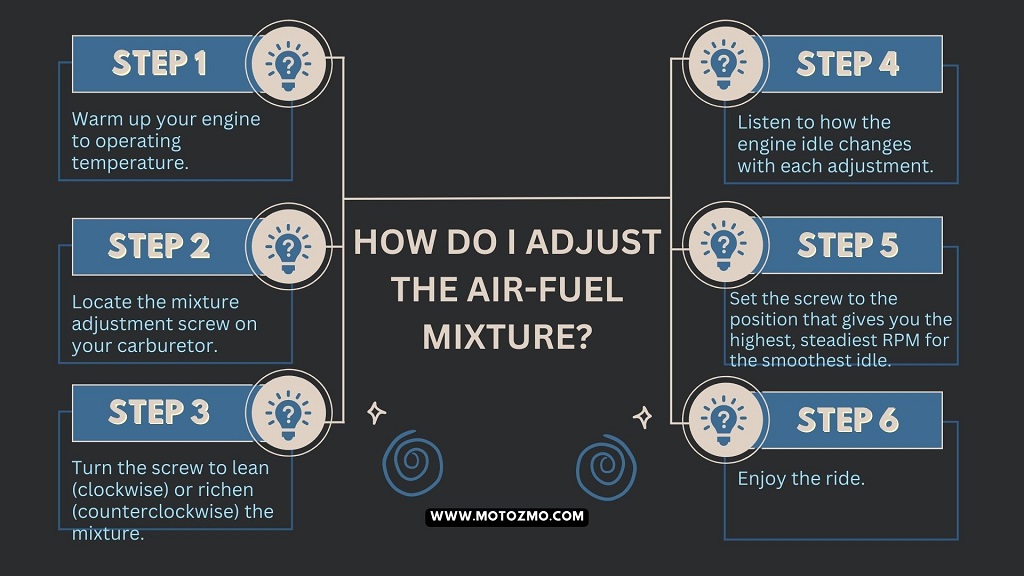
1. Warm up the Engine
Before you touch anything, let the engine idle for 5 to 10 minutes. You want it fully warmed up. Cold engines naturally run rich, so adjusting the carb while it’s cold will throw everything off once the bike heats up.
Listen for signs: a smooth, steady idle means your engine is happy. Any stumbling, coughing, or shaking means the mix probably needs correction.
2. Locate the Mixture Screw
Find the air-fuel mixture screw on the carburetor body. It’s usually:
- A flat-head brass screw
- Near the bottom side of the carb, close to the engine
- Slightly recessed or capped (on newer bikes)
There are two types of screws:
- Fuel screw (after the throttle plate, controls fuel): turn out to enrich
- Air screw (before the throttle plate, controls air): turn in to enrich
Most motorcycles use a fuel screw, especially 4-strokes. Know what you’re working with.
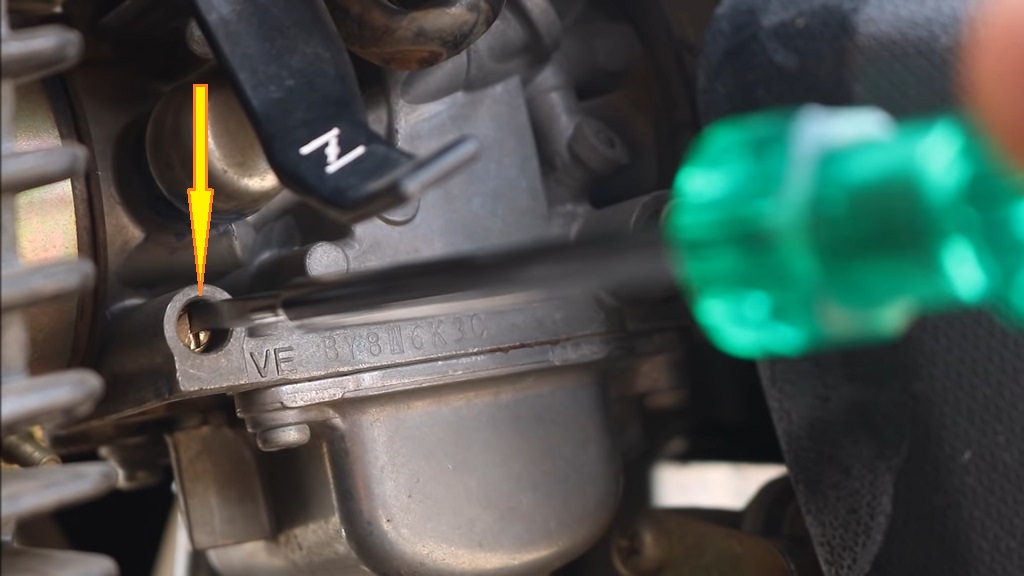
3. Use the Peak-RPM Method
This is the most accurate method you can use without special tools:
Step-by-Step:
- Turn the screw in slowly (clockwise) until the RPM begins to drop. You’re making the mix leaner.
- Now turn it out (counterclockwise) slowly until the RPM drops again. This makes it richer.
- The highest RPM point between the two drops is your ideal setting.
Bonus Adjustment:
Once you find peak RPM, turn the screw out just a hair more, around 1/8 to 1/4 turn. This gives the engine a slightly richer mix, which is safer and improves throttle response.
This technique is used by mechanics and racers alike, and it’s far more accurate than guessing or tuning by ear alone.
4. Reset the Idle Speed
Now that your mixture is spot-on, it’s time to adjust the idle.
Find the idle speed screw (usually located near the throttle linkage on the carb body). Turn it:
- Clockwise to increase idle speed
- Counterclockwise to lower it
Your owner’s manual should list the correct RPM, usually around 1,200–1,500 RPM for most bikes.
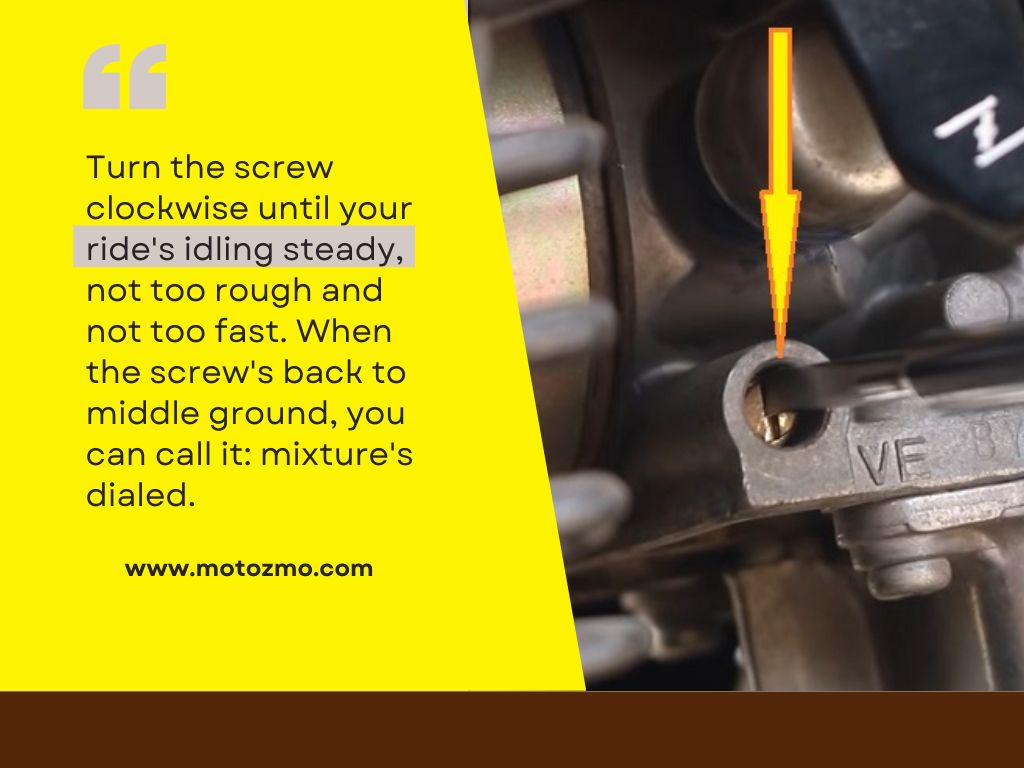
5. Optional: Sync Multiple Carburetors
If your engine has two or more carburetors (common on older 2- or 4-cylinder bikes), you’ll need to sync them so each one feeds its cylinder evenly.
You’ll need:
- A vacuum gauge set
- Or an electronic synchronizer like DigiSync
Syncing ensures balanced performance and avoids vibration or uneven engine wear.
6. Optional: Use Advanced Tools for Precision
- Tachometer
Helps you detect minor RPM changes during tuning. It’s especially helpful for older bikes without a digital display. - Wideband O₂ Sensor or CO Analyzer
These measure the actual exhaust gases, giving you a clear picture of your air-fuel ratio. Ideal for racers or anyone doing performance tuning.
7. Optional: Fix Mid-Range Tuning Issues
If your bike runs great at idle but hesitates under throttle, the problem could be:
- The needle position is wrong (adjust needle clip)
- The main jet is too small or large
- Pilot jets need cleaning or swapping
Fine-tuning these components improves throttle response and power delivery across the RPM range.
8. Optional: Adjust for Altitude
Higher altitudes mean thinner air. If you live or ride in the mountains:
- Your bike may run rich
- Consider going one size smaller on main and pilot jets
- Or lean the mixture slightly to compensate
This step can dramatically improve fuel economy and throttle feel at elevation.
9. Optional: Use Factory Settings and Spark Plug Color
If you’re unsure where to start, check your service manual. Most bikes recommend a starting point, usually 1.5 to 2.5 turns out from lightly seated.
You can also remove your spark plug after tuning and check the tip:
- Light gray/tan = good
- Black and sooty = too rich
- White and dry = too lean
This “plug reading” method is old-school, but it still works.
Looking for a video tutorial? Watch this:
Adjusting the Air-Fuel Mixture: Some Tips
- Adjust one carb at a time on multi-carb engines.
- Go slow, adjust in 1/8-turn steps.
- Keep notes on screw positions.
- Warm up the engine before final tuning.
- Don’t test at high RPM in neighborhoods, it’s loud and risky.
- Use thread locker on mixture screws if they tend to loosen from vibration.
- Avoid overtightening the screw when seating it. It can damage the tip or seat.
FAQs about Adjusting Motorcycle Carburetor Air-Fuel Mixture
How often should I tune my motorcycle carburetor?
Check or tune your carb every 3,000 to 5,000 kilometers (or every few months). Ride in dusty conditions? Tune more often.

